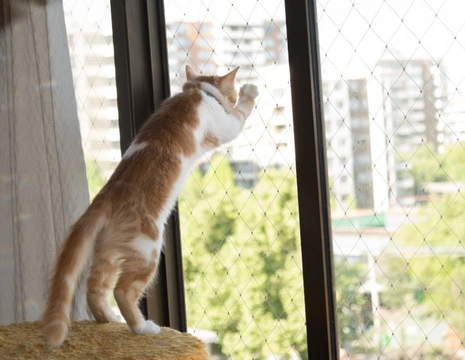
How to prevent your cat from falling if you live in a high-rise apartment
A cat is a viable choice of pet if you live in a higher-up apartment, as long as you have enough space and are able to provide sufficient entertainment and enrichment to make up for the inability of your cat to roam outside.
However, keeping a cat in an apartment does come with the small but significant risk of your cat falling from a window or balcony; problems that can occur in various other types of high-up accommodation too, such as houses with several stories and/or attics that offer access to outside, or that have roof gardens or terraces on higher floors.
Falls from high-up housing (including, but not limited to, higher-floor apartments) is known as high-rise syndrome in cats, and the risk of this happening can be greatly reduced and almost negated entirely with a little forethought.
Knowing the risks and how or why a cat might come to fall from an apartment, plus how to mitigate them, is vital if you live on a higher floor or your cat can get up to a height above two stories in another form of accommodation.
This article will explain the steps that you can take to prevent or at least minimise the risks of your cat falling from your high-rise apartment or upper stories of taller homes. Read on to learn more.
Screen over open windows
First of all, any windows that your cat could get through (which means some quite small ones and those that might have safety fitments to prevent them opening more than a few inches) need to be screened. Using screens made of a transparent or opaque mesh can allow you to open windows and get some airflow and sunlight and be able to see out, while stopping your cat from being able to get out of the window.
Fabric net on a stiff framework can be used for this, but bear in mind that some cats might claw at it and be able to make openings within it. A firmer nylon mesh is more cat-safe, and will be more hardwearing too.
Screens of this type can be fitted to the window permanently and left in place open or closed, or may be removable and stored out of the way when the window is closed.
Be vigilant about their use every time you open a window either way, to prevent your cat going out onto the windowsill and risking a fall. Also, make sure that the screening is secured when pushed from inside; it is no good if your cat leaning their weight against it or standing up with their paws on it pushes it out of the window, for obvious reasons.
Know what constitutes safe cat-proof balcony fencing
Cat-proofing a balcony or balcony fencing can be a challenge as there are a lot of things to bear in mind. Clear Perspex or toughened glass screens are cat-proof, but only up to the height they reach; and they may have gaps between panes or at the sides and bottom that your cat could fit through.
Metal bars need to be rather closer together than you might assume to be cat-proof, and again, they only work up to the limits of their height. Brick balcony walls once more, are then open to the air where they stop.
This means that you need to assess first of all the lower level of the balcony’s boundary, and then look at cat-proofing the part above it too.
Cat screening for balconies
Above the wall/fence or lower part of the balcony’s boundary, you also need to be able to enclose this space to make it cat-safe. You might look at a balcony made of lower-level Perspex screens and assume your cat won’t try to jump onto or over it as it does not have a shelf or sill to it like say, a brick wall does, but this is not a safe assumption.
Using Perspex or toughened glass screens to enclose the higher level of the balcony boundary is an option (again securing any gaps too) as is mesh screening and fully enclosed nets, the latter once more with the caveat that some materials might be liable to getting shredded by your cat’s claws.
Consider where your cat could go from your balcony
Securing the front of the balcony (the part facing the drop) might seem self-evident, but you should also take steps to secure your balcony to keep your cat from being able to get off it onto a neighbouring balcony or another area to the sides, or even above it too. Even if getting off the balcony in this way does not come with the risk of a fall in and of itself, where they can go from there might; and of course, will mean your cat has disappeared anyway.
Supervise your cat when on the balcony, roof garden, or terrace
It is also good practice to supervise your cat when they are on the balcony, terrace, or roof garden, even if you have secured it well. This helps to ensure you know where your cat is and that they are safe.
Assess balcony furniture to ensure your cat can’t use it to get to another property or bypass nets and screens
Finally, check out where you’ve got furniture, or even things like plants or washing hanging on your balcony or similar space to ensure it could not serve as a climbing frame for your cat to get up to the balcony above, or over/out of netting or screens.



